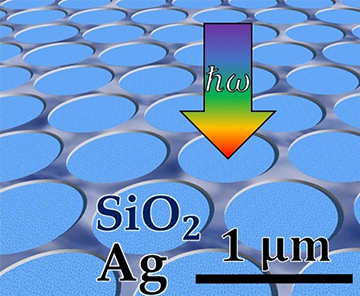
An approach called colloidal lithography results in a silver nanopattern that conducts electricity while letting light through the holes. The new transparent electrode films could be useful for solar cells as well as flexible displays and touch screens. [Image: Jes Linnet, University of Southern Denmark]
Researchers at a Danish university have developed a transparent, conductive electrode film from nanopatterned silver (Opt. Mater. Express, doi:10:1364/OME.8.001733). The silver-on-plastic film, made via a large-scale fabrication process called colloidal lithography, could find applications from flexible displays to touch screens and even solar cells.
Moving away from brittle materials
Indium tin oxide has been the common choice for electrodes that need to be transparent at visible wavelengths. However, the semiconductor is too brittle to use in flexible devices, demands tricky high-temperature manufacturing processes and has a finite global supply. Scientists around the world have been trying alternative materials, ranging from patterned noble-metal grids to carbon nanotubes, that might make a better flexible display screen.
A team at the University of Southern Denmark took a different approach to the use of a precious metal such as silver. First, they built a 10-cm-wide hexagonal template out of a monolayer of polystyrene particles on a quartz substrate and shrank the particles via inductively coupled plasma reactive-ion etching. According to lead author Jes Linnet, a graduate student at the university's Center for Nano Optics, keeping the micron-sized particles in place while reducing their size was the greatest challenge he and his colleagues faced.
During the etching process, Linnet says, ionized oxygen surrounds the polystyrene particles, causing them to shrink. “We found, however, that the particles tended to move a little during this process,” he adds. “The random motion of each particle caused significant periodicity deviation in the large-scale hexagonal pattern.” His team overcame the problem by cooling the microsphere wafer to −20 ºC during etching, which kept the tiny components in place.
Conduction and transmittance
Once the template was built, the researchers used electron-beam evaporation to deposit a 3-nm-thick titanium adhesion layer and a 30-nm-thick layer of silver on the patterned plastic. The silver settled in the spaces between the particles. Linnet's team then chemically dissolved the polystyrene template, leaving an array of light-transmitting holes within an electrically conductive grid.
The researchers then measured the silver film's optical transmittance and electrical sheet resistance and compared them to computer models. The results showed optical transmittance of up to 80 percent with electrical sheet resistance below 10 ohms per square.
Linnet says he and his colleagues have already tested these transparent conductive thin films as electrodes in organic photodiodes, and they obtained “super-linear “current-voltage characteristics. “Except for upscaling, optimization and tailoring to accommodate specific substrates, I don't think more research is required,” he adds.
